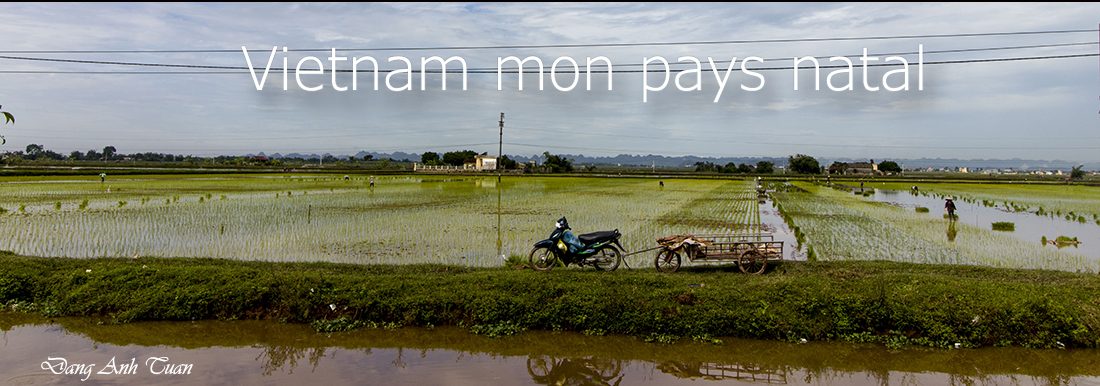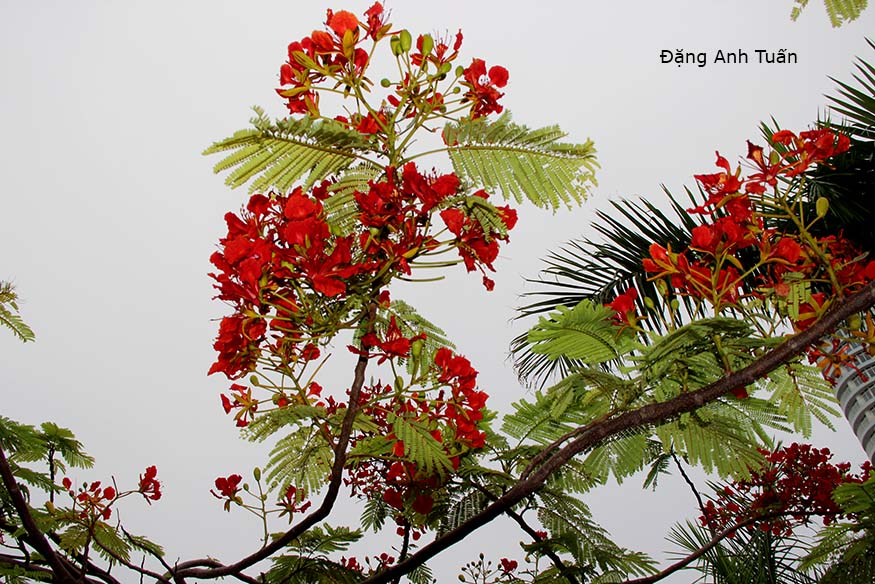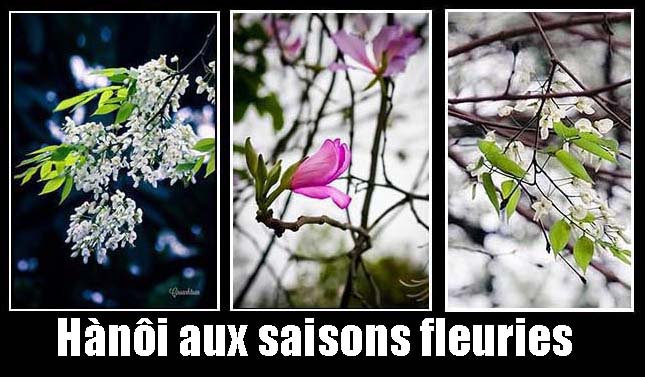Hànội với những mùa hoa nở
Au gré des saisons, la capitale Hànội se couvre de fleurs différentes. Celles-ci ont chacune un parfum et une couleur typique associée souvent à l’expression d’un sentiment. On est habitué à dire « Mùa nào thức nấy » (À chaque saison correspond un fruit ou une fleur). Selon l’écrivain Hữu Ngọc, la plantation des arbres sur les trottoirs de la capitale est un apport de l’urbanisation française, le fruit d’une acculturation Ouest-Est. Dans le livre intitulé « Les Fleurs de Hanoï », le poète vietnamien Trần Lê Văn a estimé plus de 200.000 arbres en 1980. A l’approche du Têt, outre les fleurs de cérisier (Hoa đào), on se retrouve avec les fleurs de Dalbergia tonkinensis Prain (Hoa Sưa) symbolisant la pureté dans les jours de léger crachin associé souvent au vent du Nord. La floraison du Bauhinia variegata (Hoa ban tím) à la fin du mois de mars ébranle la jeunesse hanoïenne qui se dépêche pour se faire prendre en photo.
En été, les magnifiques fleurs de flamboyant (Hoa phượng vỹ) ne passent pas inaperçues avec leur couleur rouge éclatante, symbole de la chaleur des sentiments et de la gaieté. Elles sont accompagnées souvent par les chants assourdissants des cigales. Elles annoncent également la venue des examens et des vacances. On trouve une note de tendresse dans certains coins avec les fleurs de Lagerstroemia speciosa ou Lilas des Indes (Hoa bằng lăng) de couleur mauve. Quant aux fleurs de lotus, on ne les trouve qu’au lac de l’Ouest (Hồ Tây). Les amateurs de fleurs ne peuvent pas rester indifférents face à leur beauté et leur splendeur. Malgré leur petite taille, elles continuent à ne pas sentir l’odeur d’une boue fétide. Puis en automne, les fleurs d’Alstonia scholaris (Hoa sữa) d’un blanc laiteux enivre les passants avec leur parfum. Elles réussissent à conquérir le cœur des Hanoiens. Le coin d’Europe est rappelé en hiver par le dénuement des branches d’arbres Cây Sêu (Celtis australis) trouvé sur un fond de ciel pâle. Hanoï reste une ville éternelle et historique au fil des saisons.
Toutes ces fleurs ne manquent pas d’apporter à Hanoï
un attrait à la fois historique et séduisant,
ce qui donne un souvenir inoubliable à ceux qui ont l’occasion d’y vivre.
Hànội vắng những cơn mưa
Hànội , une saison absente de pluies
(Trương Qúi Hải)
Tùy theo các mùa mà thủ đô Hà Nội có được các loài hoa khác nhau. Mỗi loại đều có một mùi hương đặc trưng và màu sắc thường được kết hợp đ ể ph át bi ểu sự cảm xúc. Chúng ta thường nói “Mùa nào thức nấy” (Mỗi mùa tương ứng với một loại trái cây hoặc một loài hoa).
Theo nhà văn Hữu Ngọc, việc trồng các cây xanh trên vỉa hè thủ đô là sự đóng góp của đô thị hóa theo kiểu Pháp, kết quả của sự tiếp biến văn hóa Tây-Đông.
Trong quyển sách có tựa đề “Hoa Hà Nội”, nhà thơ Việt Trần Lê Văn ước tính có hơn 200.000 cây vào năm 1980. Gần đến ngày Tết, ngoài hoa đào, chúng ta còn có loài hoa Dalbergia tonkinensis Prain (Hoa Sưa) thể hiện sự thanh khiết trong những ngày mưa phùn nhẹ tênh thường gắn liền với gió bắc. Còn hoa ban tím (hay là hoa Bauhinia variegata) thì vào cuối tháng ba làm nôn nao giới trẻ Hà Thành, cùng nhau vội vã đi chụp ảnh. Vào mùa hè,thì không thể không chú ý đến những bông hoa phượng vĩ với màu đỏ thắm rực rỡ, biểu tượng cho sự nồng ấm trong cảm xúc và sự vui tươi, hay thường được kèm theo với tiếng ve sầu và cũng thông báo có các kỳ thi sắp đến và các kỳ nghỉ hè.
Sự dịu dàng cũng được trông thấy ở một số địa điểm với các hoa tím của Lagerstroemia speciosa hoặc hoa bằng lăng. Còn hoa sen thì chỉ thấy được ở Hồ Tây mà những người yêu hoa không thể hững hờ được trước vẻ đẹp lộng lẫy của nó. Dù có kích thước nhỏ nhưng hoa vẫn không hề có mùi bùn hôi.
Sau đó đến mùa thu, những hoa trắng sữa (hay Alstonia scholaris) làm say lòng người qua đường với hương thơm của chúng. Các hoa đã thành công trong việc chinh phục được trái tim của người Hà Nội. Góc trời châu Âu c ũng được gợi lại vào mùa đông qua những cành cây trơ trụi của cây Sêu (Celtis australis) trên nền trời nhợt nhạt. Hànôi vẫn là một thành phố lịch sử và vĩnh cửu qua các mùa.
Tất cả loài hoa này mang đến cho Hànội sức quyến rũ và sức thu hút về lịch sử, khiến để lại một kỷ niệm khó quên cho những ai có cơ hội được sống ở nơi nầy.
Saxophoniste Quyền Văn Minh
Depending on the season, the capital Hànội is covered in different flowers. They each have a perfume and a typical color often associated with the expression of a feeling. It is accustomed to say « Mùa nào thức nấy » ( Each season is designed for a fruit or a flower). According to writer Hữu Ngọc, the planting of trees on the sidewalks of the capital is a contribution of the French urbanization, the fruit of a West-East acculturation. In the book entitled « The Flowers of Hanoi », Vietnamese poet Trần Lê Văn has estimated more than 200,000 in 1980. At the approach of Tết, in addition to the cherry blossom (Hoa đào), one finds the flowers of Dalbergia tonkinensis Prain (Hoa Sưa) symbolizing the purity in the days of light drizzle often associated to the north wind. The flowering of the Bauhinia variegata (Hoa bàn tim) at the end of March shakes Vietnamese youth who hurries to take a picture.
In summer, the beautiful flowers of flamboyant (Hoa phượng vỹ) are visible with their color bright red, a symbol of the warmth of feelings and gaiety. They are often accompanied by the deafening songs of cicadas. They also announce the coming of the exams and holidays. There is a note of tenderness in some corners with purple flowers of Lagerstroemia speciosa or Myrtles (Hoa bằng lăng). With lotus flowers, one only finds it in the West lake (Hồ Tây). The flower lovers cannot remain indifferent to their beauty and splendor. Despite their small size, they continue not to smell of fetid mud. Then, in the autumn, the milky white flowers of Alstonia scholaris (Hoa sữa) intoxicate passersby with their perfume. They manage to conquer the Hanoiens heart.
The corner of Europe is recalled in winter by the destitution of the branches of trees Cây Sêu (Celtis australis) founded in a background of pale sky. Hànội remains an eternal and historic city over the seasons.
All these flowers don’t fail to bring an historic and enticing lure to Hànội. This give an unforgettable experience to those who have the opportunity to live here.


